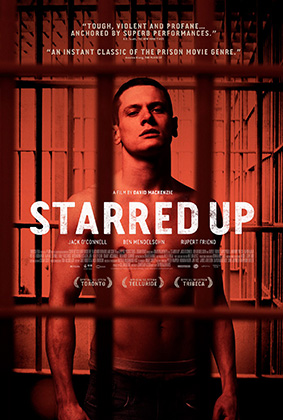
“Starred Up” is a striking prison film. It always feels real, and is rarely anything less than gripping. But in between all the prison politics and morally ambiguous inmates, the film loses its footing when it becomes predictable. Still, its plot, dark as it may be, is massively entertaining.
Directed by David McKenzie, the British film follows 19-year-old Eric (Jack O’Connell) as he copes with the transfer from a youth institution to an adult prison facility. He is caught between hostile guards, vicious fellow inmates and his own imprisoned father (Ben Mendelsohn).
For the most part, this premise revels in the patterns of a prison film. There are the usual fights with sharpened toothbrushes, and routine illicit weaponry; there are scenes in the yard, the shower and solitary confinement; and there is gang politics with the full rosters of head honchos, corrupt guards and shifty side characters who will act out of line as expected.
“Starred Up” sneaks in much more than standard prison-movie fare, however. Rupert Friend’s character, an unconventional prison therapist running small group sessions, teases Eric and the audience with glimpses of redemption and escape from the violent anarchy of the prison. Eric’s relationship with his father hints at a depth of psychology not usually touched upon in genre films.
In both the film’s original bits and its stock scenes, Friend’s performance, paired with the performances from Mendelsohn, O’Connell and the rest of the cast, is worthy of all the praise it has gotten. Especially admirable is Friend as the prison therapist. Where O’Connell, Mendelsohn and most of the cast provide glimpses of tragic figures simply trying to survive, Friend’s character embodies a strange offer of salvation for the inmates. Yet Friend still seems to exhibit some form of anger, violence and despair, making the audience question whether he can really help the inmates or if he himself is being dragged deeper into the brutal world of prison.
O’Connell’s protagonist is physically, intellectually and emotionally muscular. Eric’s presence is as much, if not more so, communicated through physical stature, eye movements and tastefully restrained facial expressions than through his words and actions, and the result is terrifyingly real for the audience. Mendelsohn’s father figure is similar — he often teeters, even within the same scenes, between an ineffectual-yet-deeply-loving father and a monstrous product of years in a hostile closed environment.
The film makes several stabs at authenticity — the screenplay was written by Jonathan Asser, who has experience as a prison therapist, and MacKenzie required his crew to live within the prison while filming. Many times, the film’s unflinching realness pays off, and it becomes difficult to watch without feeling as if it were a real prison with real prison drama.
The pitfall, however, is that prison films are genre films — they do not depict real prisons with real prison dramas. You can sit down to watch “Starred Up” and guess probably about a third of the events of the film, simply due to genre constraints. Although “Starred Up” fails to revolutionize the prison film, the antics of this particular prison are sure to entertain.
Jesse James Read is a contributing writer. Email him at [email protected].






















































































































































